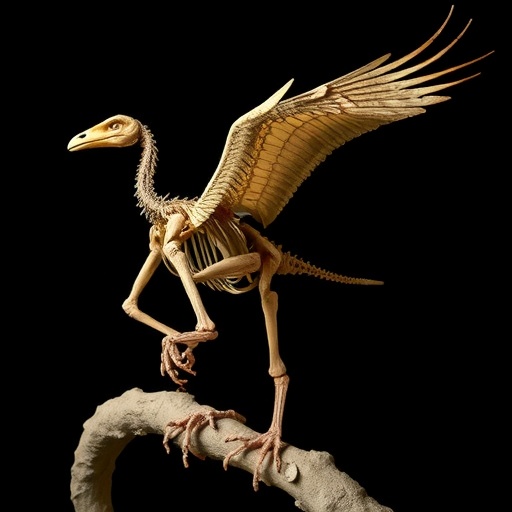A Remarkable Glimpse into the Dawn of Avian Evolution: The Nearly Complete 14th Specimen of Archaeopteryx
In a groundbreaking discovery that promises to reshape our understanding of early avian evolution, a team of paleontologists has reported on the remarkably well-preserved 14th specimen of Archaeopteryx. Unlike many previous finds, which have suffered from crushing or incomplete preservation, this specimen is both nearly complete and exceptionally intact. Its preparation was meticulously guided by advanced micro-computed tomography (micro-CT) scanning techniques, enabling researchers to unravel minute anatomical details that have long eluded scientific scrutiny.
The significance of this specimen extends beyond its pristine condition. Archaeopteryx has long been heralded as a pivotal transitional form linking non-avian dinosaurs and modern birds, but this find presents an unparalleled opportunity to investigate the complex shifts in skeletal morphology and feather evolution. The data extracted illuminate the gradual acquisition of flight, one of the most consequential adaptations in vertebrate history, through a detailed examination of both bone structure and plumage arrangement.
A standout feature revealed by micro-CT imaging is the ventrolaterally exposed skull, which displays palatal characteristics that appear intermediate between derived troodontids and more crownward Cretaceous birds. This novel insight suggests that Archaeopteryx possessed a cranial morphology bridging two major theropod groups, offering key evidence of how cranial architecture was reshaped during the origins of flight. Unlike its non-avian dinosaur ancestors, the skull of Archaeopteryx exhibits modifications consistent with a trend toward increased cranial flexibility, perhaps facilitating enhanced feeding mechanics or sensory capabilities.
Extending from this, the specimen’s vertebral column comes into astonishing detail, revealing paired proatlases — small accessory bones associated with the skull’s articulation — that were previously unknown in Archaeopteryx. Also noteworthy is the recognition that its tail was considerably longer than earlier fossil interpretations suggested. This elongated tail would have had significant biomechanical implications, potentially affecting balance and flight dynamics, and painting a more nuanced picture of the locomotive strategies employed by these early birds.
The exceptional preservation also permitted observation of integumentary structures previously debated among scientists. Skin impressions along the right major digit of the hand indicate that the minor digit was not merely reduced and immobile but was, in fact, free and distally mobile. This challenges earlier reconstructions that posited a rigid and functionally limited hand anatomy, opening fresh avenues for understanding manipulative abilities and wing articulation in basal avians.
Another intriguing anatomical revelation centers on the morphology of the foot pads. Detailed impressions suggest that Archaeopteryx was adapted for terrestrial locomotion rather than raptorial predation. The padded structure of the foot implies a gait suited for walking on firm ground, contrasting with the pedal specializations seen in modern birds of prey. Such an ecological insight helps refine previous conjectures about the lifestyle of Archaeopteryx, indicating a more ground-oriented existence alongside its aerial capabilities.
Perhaps most strikingly, this specimen preserves specialized inner secondary feathers, identified as tertials, on both wings. These feathers are absent in closely related non-avian dinosaurs, underscoring their unique evolutionary origin within Avialae. The presence of humeral tertials in Archaeopteryx contributes directly to a continuous aerodynamic surface necessary for efficient flight. This structural feature likely played a crucial role in flight mechanics, possibly improving lift and maneuverability in early birds.
The discovery of humeral tertials being absent in near relatives but present in Archaeopteryx underscores an important evolutionary milestone: a mosaic emergence of flight adaptations rather than a sudden, single-step shift. The evolutionary narrative that arises is one of gradual transformation where skeletal and feather features co-evolved to form the sophisticated flying apparatus characteristic of modern birds.
This specimen therefore fills a critical gap in our understanding of the bauplan — the fundamental structural design — of early birds. It reveals that Archaeopteryx was not a simple evolutionary intermediate but rather bore a unique combination of ancestral dinosaurian and derived avian traits, illustrating a complex evolutionary mosaic. This explains why Archaeopteryx continues to be a touchstone taxon in studies of avian origins, contextualizing its ecological role and morphological innovations in unprecedented detail.
By refining ecological predictions, these findings also prompt reevaluation of how early birds interacted with their environments. The integration of skeletal flexibility, feather arrangement, and pedal adaptations suggests a multi-faceted lifestyle that balanced terrestrial foraging with emergent flight abilities. Such nuanced reconstructions of early avian behavior enrich our broader understanding of Mesozoic ecosystems.
The study sets a new standard for the application of modern imaging techniques to fossils, demonstrating how micro-CT driven preparation can reveal concealed morphological data without destructive intervention. This approach exemplifies the power of technological advancement in paleontology, allowing researchers to push back the limits of what can be discerned from fossils and reconstruct the evolutionary past with ever-increasing precision.
In sum, the nearly complete 14th specimen of Archaeopteryx from Chicago constitutes a landmark in paleontological research. It advances our knowledge about the origin and evolution of flight, revealing a dynamic interplay of skeletal and feather adaptations that enabled the transition from terrestrial dinosaurs to volant birds. This discovery not only enriches the evolutionary story of Archaeopteryx but also provides critical baseline data for interpreting the early diversification of avian bauplans.
As the scientific community digests these revelations, this specimen will undoubtedly remain a cornerstone for future research aimed at disentangling the complex evolutionary pathways that produced today’s vast and diverse avian clade. It stands as a vivid reminder of the intricate and gradual nature of evolutionary change, captured in the fossil record by one of the most iconic taxa in the history of science.
Subject of Research: Early evolution of the avian bauplan based on a new nearly complete Archaeopteryx specimen.
Article Title: Chicago Archaeopteryx informs on the early evolution of the avian bauplan.
Article References:
O’Connor, J., Clark, A., Kuo, PC. et al. Chicago Archaeopteryx informs on the early evolution of the avian bauplan. Nature (2025). https://doi.org/10.1038/s41586-025-08912-4
Image Credits: AI Generated




